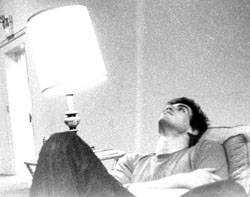

Some Food For Thought: Conversation
Becomes Art
BY CATHARINE RICHERT
It is not every day that Fisher Hall is turned into a living room. The
fact that Fisher is primarily used to display non-interactive paintings,
photographs and sculpture makes senior Andrew Styer’s senior exhibition
cracked open a small world even more striking.
 (photo by Pauline Shapiro) |
Instead of the typical array of framed
wall pieces and distant installation art, Styer uses the space to create
a common ground, an area where visitors can drop in, interact with their
surroundings, eat and simply communicate. The exhibit, which began Monday,
will be on display through Friday.
The area is created with mismatched chairs and couches circularly situated
near the entrance of Fisher. The worn, cushy furniture invites the visitor
to take a seat and relax. Against the far wall, there is a long blue
table accompanied by kitchen table chairs where Styer serves dinner
every day at 7 p.m. Soft lighting filters from four yellow walls installed
at either end of the room.
Another striking feature of Styer’s space is his use of primary colors.
The floor is painted red in areas, paired with a blue table and yellow
paneling. Reminiscent of childhood classrooms and finger-painting, these
colors bring Fisher to life.
Styer said he hopes the colors will put people at ease. “Colors give
a lot more life to this space. They make me happy and playful,” Styer
said.
Despite the initial reaction of “Cool. What a neat room,” the viewer
may become confused as to what Styer’s motivation is. The artist’s transformation
of Fisher is an extension of an earlier photography series called Dying
is Easy..., which explored the hardships of daily living that make the
enjoyment of life more challenging.
“Living is hard,” Styer writes in his personal statement, “All the pressure
this place can bring to bear, about what I should do with my life, what
I should be and care about and fight for...How the hell anyone finds
their way coherently through this whole mess is beyond me.”
Although the original photographs are not included in Styer’s exhibit,
they provided a point of reference. When life becomes most trying, interactions
and connections become a great comfort. Styer thus strives to create
a space where these essential exchanges come alive.
“I want there to be the chance for people to recognize themselves in
each other, to touch and be touched in return,” Styer writes. “The ritual
of conversation and social interactions, for me then becomes the artwork...the
art is off the wall, brought into peoples’ lives in hopes that they
will remember and treasure the interactions they have...to refresh them
when they need it.”
If conversation is art, it is questionable if Styer can claim these
interactions as his work. “If I make anything, it’s the space,” Styer
said. “I tried to set up the space to encourage these interactions.
I can’t ever claim the reactions that happen in there as my own...It’s
a weird thing — it requires audience participation, it makes the viewer
work more.”
The philosophy behind the creation of Styer’s “den” is its strongest
facet. The actual design of the space is lacking in tangible creativity.
Despite Styer’s attempt to make Fisher Hall look less drab, the area
still feels fake and consequently less comfortable. The set up of the
furniture and installations do not indicate much thought in placement;
there is very little pure artistic quality in the entire room. The viewer
is inevitably compelled to ask “It this really art?” Since Styer provides
virtually no explanation for his layout, any essence of artistic motivation
becomes flimsy. It is an immense challenge to create a non-artistic
space in an established gallery, and Styer proves to be only mildly
successful in doing so.
One thing is certain, however:
unconventionality is key to Styer’s work. His use of quotidian objects
and activities challenge traditional ideas of what constitutes art.
Additionally, his work initiates questions of how gallery space dictates
ideas and interactions with art. Just as some artists paint a landscape
to
demonstrate the beauty of life, Styer creates a space where friends
and strangers can discover life’s beauty through each other. So stop
by. Take a load off. Connect.
![]()
Students Bring Quartett's Sinister Eroticism to Life
New Student Poetry Group Opens for Alix Olson
FAVA Show Has Promise, but Comes Up Short